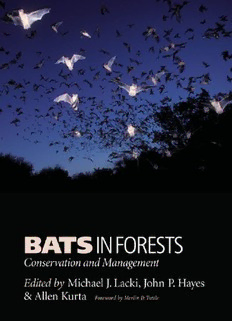
Bats in Forests: Conservation and Management PDF
Preview Bats in Forests: Conservation and Management
BATS IN FORESTS This page intentionally left blank BATS IN FORESTS CONSERVATION AND MANAGEMENT Edited by Michael J. Lacki, John P. Hayes, and Allen Kurta Foreword by Merlin D. Tuttle THE JOHNS HOPKINS UNIVERSITY PRESS BALTIMORE This book was brought to publication with the generous assistance ofthe National Congress ofAmerican Indians, Bat Conservation International, and the Bat Diversity Network. © 2007 The Johns Hopkins University Press All rights reserved.Published 2007 Printed in the United States ofAmerica on acid-free paper 1 2 3 4 5 6 7 8 9 The Johns Hopkins University Press 2715 North Charles Street Baltimore,Maryland 21218-4363 www.press.jhu.edu Library ofCongress Cataloging-in-Publication Data Bats in forests :conservation and management / edited by Michael J.Lacki,John P.Hayes, Allen Kurta. p. cm. Includes bibliographical references and index. ISBN 0-8018-8499-3 (hardcover :alk.paper) 1.Bats—Ecology—North America. 2.Bats— Effect offorest management on— North America. 3.Bats—Conservation— North America. I.Lacki,Michael J.,1956– II.Hayes,John P.(John Parker) III.Kurta,Allen,1952– QL737.C5B373 2007 639.97(cid:1)94—dc22 2006013034 A catalog record for this book is available from the British Library. Photographs at chapter openers are by Merlin D.Tuttle,Bat Conservation International To Sonia,Ashley, and Marty– for always being there To Joan,Heather, and Forest To my‘Little Red Wife,’ for being my best friend This page intentionally left blank CONTENTS Foreword,by Merlin D.Tuttle ix Preface xi Contributors xv 1 BATS IN FORESTS: WHAT WE KNOW AND WHAT WE NEED TO LEARN R.Mark Brigham 1 2 ECOLOGY AND BEHAVIOR OF BATS ROOSTING IN TREE CAVITIES AND UNDER BARK Robert M.R.Barclay and Allen Kurta 17 3 BEHAVIOR AND DAY-ROOSTING ECOLOGY OF NORTH AMERICAN FOLIAGE-ROOSTING BATS Timothy C.Carter and Jennifer M.Menzel 61 4 FORAGING ECOLOGY OF BATS IN FORESTS Michael J.Lacki,Sybill K.Amelon,and Michael D.Baker 83 5 IMPORTANCE OF NIGHT ROOSTS TO THE ECOLOGY OF BATS Patricia C.Ormsbee,James D.Kiser,and Stuart I.Perlmeter 129 6 MIGRATION AND USE OF AUTUMN, WINTER, AND SPRING ROOSTS BY TREE BATS Paul M.Cryan and Jacques P.Veilleux 153 7 SILVICULTURAL PRACTICES AND MANAGEMENT OF HABITAT FOR BATS James M.Guldin,William H.Emmingham,S.Andrew Carter, and David A.Saugey 177 8 THE INFLUENCES OF FOREST MANAGEMENT ON BATS IN NORTH AMERICA John P.Hayes and Susan C.Loeb 207 9 ECOLOGICAL CONSIDERATIONS FOR LANDSCAPE-LEVEL MANAGEMENT OF BATS Joseph E.Duchamp,Edward B.Arnett,Michael A.Larson, and Robert K.Swihart 237 10 ASSESSING POPULATION STATUS OF BATS IN FORESTS: CHALLENGES AND OPPORTUNITIES Theodore J.Weller 263 11 PLANNING FOR BATS ON FOREST INDUSTRY LANDS IN NORTH AMERICA T.Bently Wigley,Darren A.Miller,and Greg K.Yarrow 293 Author Index 319 Species Index 325 Subject Index 327 This page intentionally left blank FOREWORD Today,many bat populations are only small remnants of former num- bers.Prior to the arrival ofEuropean settlers in the United States,for ex- ample,millions ofnow endangered Indiana and gray myotis lived in sin- gle caves. Even species that are still considered common have, in fact, declined markedly.For example,in the 1870s great migratory flocks of eastern red bats were reported to pass over for days at a time during fall migration,a sight now vanished from American skies. Despite their decline and an increase in conservation concern, bats still rank among the world’s most neglected and misunderstood mam- mals.Few members ofthe public understand that the world’s more than 1,100 species play essential ecological roles in all but the most extreme desert and polar regions. Fewer still know that most of America’s 51 species rely on forests to varying degrees,either for food or shelter.In turn,forests nearly everywhere benefit from bats,probably much more than is realized.The most abundant bats inhabiting forests consume vast quantities of insects nightly,including costly “pests”such as moths and beetles.In short,the available evidence suggests that bats are essential to ecological balance and forest health,fulfilling the same roles by night as birds do by day. A variety offactors related to forest conditions have contributed to bat decline, including disturbance of hibernation and nursery caves in forests,loss of snags and major cavities in ancient trees,careless use of pesticides in forest settings,and early neglect offorest management.For- est bats often require loose,exfoliating bark and other cavities in extra tall trees that are dying or newly dead,and these are now scarce in many places.Bats also require alternative roosts in close proximity,in part be- cause exfoliating bark and old snags are ephemeral in nature,and in part because they must find varied temperatures and avoid predators. Management practices that ensure age diversity oftrees,retain snags and damaged trees,and aid plant diversity can greatly benefit bat popu- lations.When forests become monocultures, bats and other insectivo- rous animals encounter unfavorable conditions such as prey cycles that produce fewer species of insects and longer gaps between hatch cycles. The eventual explosions ofthese insects then results in their designation as major forest pests.Both forests and bats are more secure when struc- tural,floral,and faunal diversity are maintained.For these reasons,the
